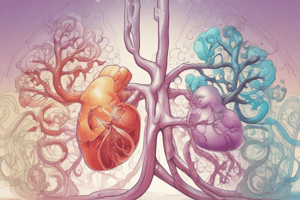Podcast
Questions and Answers
Explain the difference between lung volume and lung capacity. Provide examples of each.
Explain the difference between lung volume and lung capacity. Provide examples of each.
Lung volume represents a single volume of air into the lungs, while lung capacity represents 2 or more volumes added together. Examples of lung volumes include tidal volume and residual volume, while examples of lung capacities include functional residual capacity and inspiratory capacity.
What are the characteristics of a restrictive pattern of respiratory disease? Provide examples.
What are the characteristics of a restrictive pattern of respiratory disease? Provide examples.
A restrictive pattern of respiratory disease is characterized by an overall reduction of volumes and capacities, along with inflation problems and decreased compliance. Examples include pulmonary fibrosis, kyphosis, and severe burns.
Describe the features of an obstructive pattern of respiratory disease. Provide examples.
Describe the features of an obstructive pattern of respiratory disease. Provide examples.
An obstructive pattern of respiratory disease is characterized by an overall increase of volumes and capacities, along with airflow problems due to narrowing or collapse that limits airflow. Examples include COPD (chronic obstructive pulmonary disorder) and asthma.
What is the relationship between TI, TE, and I:E in the context of respiratory physiology?
What is the relationship between TI, TE, and I:E in the context of respiratory physiology?
Explain the concept of vital capacity in the context of lung function.
Explain the concept of vital capacity in the context of lung function.
Which of the following represents 2 or more volumes added together?
Which of the following represents 2 or more volumes added together?
In the context of respiratory diseases, which condition is characterized by an overall reduction of volumes and capacities?
In the context of respiratory diseases, which condition is characterized by an overall reduction of volumes and capacities?
What problem is associated with the obstructive pattern of respiratory disease?
What problem is associated with the obstructive pattern of respiratory disease?
Which respiratory disease is characterized by an overall increase of volumes and capacities?
Which respiratory disease is characterized by an overall increase of volumes and capacities?
What does Vital Capacity represent in the context of lung function?
What does Vital Capacity represent in the context of lung function?
Which lung volume represents a single volume of air into the lungs?
Which lung volume represents a single volume of air into the lungs?
What is an example of a condition causing a restrictive pattern of respiratory disease?
What is an example of a condition causing a restrictive pattern of respiratory disease?
Which lung capacity represents 2 or more volumes added together?
Which lung capacity represents 2 or more volumes added together?
What is an example of a condition causing an obstructive pattern of respiratory disease?
What is an example of a condition causing an obstructive pattern of respiratory disease?
What represents the overall reduction of volumes and capacities in a restrictive pattern of respiratory disease?
What represents the overall reduction of volumes and capacities in a restrictive pattern of respiratory disease?
Flashcards are hidden until you start studying
Study Notes
Lung Volume vs Lung Capacity
- Lung Volume represents a single volume of air in the lungs
- Lung Capacity represents 2 or more volumes added together
Types of Lung Volumes
- Tidal Volume:
- Residual Volume:
- Expiratory Reserve Volume:
- Inspiratory Reserve Volume:
- Functional Residual Capacity:
- Inspiratory Capacity:
- Vital Capacity:
- Total Lung Capacity:
Patterns of Respiratory Disease
Restrictive Pattern
- Characterized by an overall reduction of volumes and capacities
- Inflation problem: restriction in inflating or expanding the lungs and/or thorax
- Decreased compliance
- Examples:
- Pulmonary Fibrosis (lung scarring)
- Kyphosis (muscles cannot contract normally)
- Severe burns (restricts expansion of the thorax)
Obstructive Pattern
- Characterized by an overall increase of volumes and capacities
- Airflow problem: due to narrowing or collapse that limits airflow
- Increased airway resistance
- Examples:
- COPD (chronic obstructive pulmonary disorder)
- Asthma
Respiratory Rate and Time
- Respiratory Rate (RR) = frequency (f)
- TI =
- TE =
- I:E =
Studying That Suits You
Use AI to generate personalized quizzes and flashcards to suit your learning preferences.



